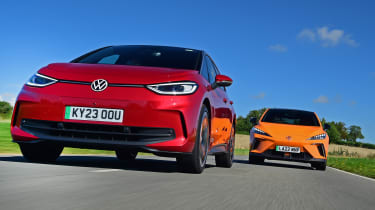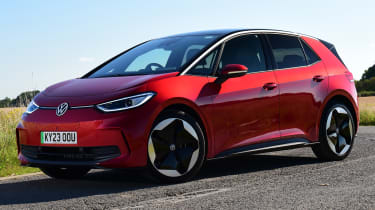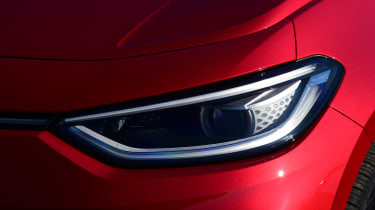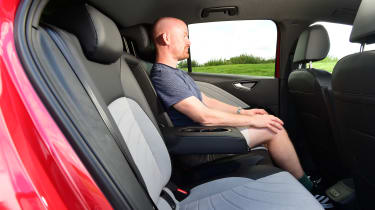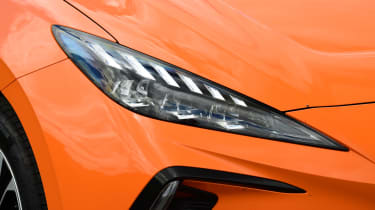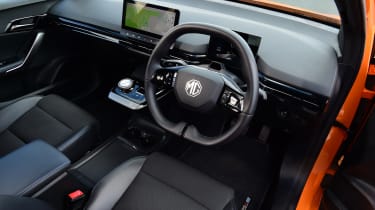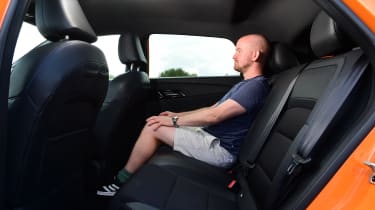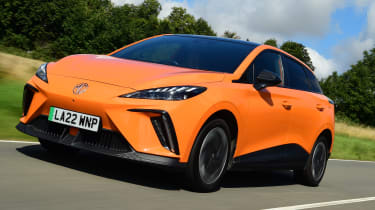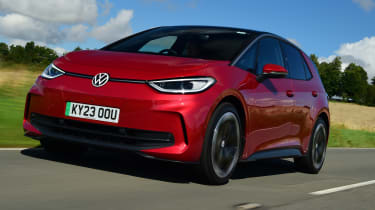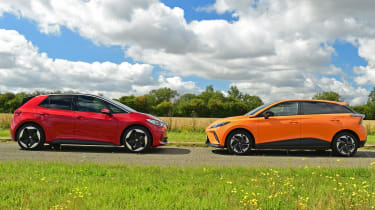Is it second time lucky for the Volkswagen ID.3? We see if early updates can see off the MG4
The Volkswagen ID.3 had big shoes to fill. Billed as the third icon in the brand’s great history after the Beetle and Golf, it led VW into the electric era, but it didn’t quite hit the mark.
Clunky ergonomics, questionable tech and above all, a shortfall in the sort of perceived quality VW buyers expect have forced the firm to introduce updates sooner than planned. Does the new car we drive here address all of the issues convincingly?
To find out, we’ve put it up against a car that might be the biggest thorn in VW’s side. The MG4 competes in the same class, and has plenty of appeal. To find out which is best, we’re putting both through our Real-World Road Test.
| Volkswagen ID.3 Pro S | MG4 Trophy Long Range | |
| Price: | £42,870 | £32,495 |
| Powertrain: | 1x e-motor/77kWh lithium-ion battery, 201bhp | 1x e-motor/64kWh lithium-ion battery, 200bhp |
| 0-62mph: | 7.9 seconds | 7.9 seconds |
| Test efficiency: | 3.8mi/kWh | 3.8mi/kWh |
| Annual VED: | 293 miles | 234 miles |
Volkswagen ID.3
The ID.3 we have here is in top-spec Pro S trim. At £42,870, it’s quite a significant price for a five-door family hatchback – even one with an electric powertrain. With options, the car in these images comes to a chunky £51,215.
Tech highlights
The Volkswagen Group invested heavily in an all-new platform to carry its brands into the electric era. The ID.3 was the first production car to feature this tech, and the on-paper specs are still strong when compared with newer rivals.
In the model we’re testing, energy is supplied by a 77kWh battery, which according to WLTP figures is enough for the ID.3 to travel up to 347 miles between charges – that’s 77 miles more than its rival here. When the time comes to plug in, a speedy 170kW charging rate can replenish the battery from 10 to 80 per cent (that’s 243 miles, WLTP) in 28 minutes.
An on-board 11kW charger also means that it can make better use of destination chargers (or if you have access to a three-phase electrical set-up) than the 7.4kW-rated MG4. A full charge takes seven-and-a-half hours, compared with nine hours for the MG.
As before, the ID.3 has a rear-mounted electric motor, and the Pro S version sends 201bhp and 310Nm of torque to the back wheels. The compact motor and gearbox weighs just 90kg, although an overall kerbweight of 1,933kg for this 77kWh model is hefty for a five-door hatchback.
Safety: When the ID.3 was tested by Euro NCAP in 2020, it scored 89 per cent in the Child Occupant category – the best mark awarded to any car tested that year. This contributed to a five-star rating overall. As well as having two sets of Isofix child seat mounts in the back, there’s a third set on the front passenger seat, too.
On the road
We've never taken issue with the way the ID.3 drives, and that still holds true. It feels much like a Golf – solid and secure, in other words, if not much fun – but with the added benefit of a smooth, near-silent electric powertrain.
Around town: The lack of driveshafts up front mean there’s plenty of steering lock and a tight turning circle. Add in short overhangs front and rear, and positioning the ID.3 at low speeds is easy.
Ownership
Along with the technical improvements, VW has also treated the ID.3 to a minor cosmetic boost.
The new bonnet loses the large, black panel that used to sit ahead of the windscreen, so the front end doesn’t look as stubby as before. Beneath this sits a revised front bumper with enlarged intakes that channel air more smoothly around the front wheels. This minor adjustment has reduced aerodynamic drag ever so slightly; it now stands at 0.263Cd, down from 0.267Cd pre-facelift.
We criticised initial examples of the ID.3 for not feeling quite as posh as one would hope for a car with a VW badge on the nose. The company has listened, and introduced foam-backed materials on the top of the dashboard and elsewhere.
The door trims have been reshaped to give a little more elbow room and more comfortable armrests, too. There’s also soft fabric here in place of the previous hard plastic, so the new material gives a much more tactile feel to a part of the car that is touched regularly.
However, this facelift hasn’t addressed all of our criticisms. One of the biggest letdowns is the touch-sensitive panel below the main screen that controls the heating and audio volume. It’s still not backlit, which makes it all-but impossible to use at night. The fiddly dual-purpose electric window switches, which require another button press to switch their function from front to rear, also remain.
Storage: With no centre console controls to worry about, the area between the driver and front passenger is dedicated to storage. The centre console houses an enormous storage bin with an adjustable partition, and ahead of it there are two deep cupholders and a small netted area at the base of the dash. The large front door bins are carpeted at their base to stop things rattling around, too. The only downside is a small glove compartment; its space is robbed by the fusebox.
Practicality
Even though the ID.3 has a smaller footprint than the Golf, clever interior packaging has delivered a car that is much roomier for passengers.
Rear Space: The cabin is more than big enough for four adults, with those in the back just as comfortable as the two up front. The Pro S trim’s rear bench is strictly for two occupants, though, which will be a sticking point for those who might occasionally want to carry a third. The Isofix child seat mounting points are easy to access within plastic housings.
Boot: At 385 litres, the boot is perfectly usable for a car in this class. The load lip is quite high, but once you’ve overcome that, the space is neatly shaped. A false boot floor is a £75 option. When equipped and set to its highest position, the seats fold almost flat to provide a level loading area with a volume of 1,267 litres.
What to buy?
Which configuration we’d choose
- Powertrains: Alongside the Pro S model, a Pro version is also available. It gets a smaller 58kWh battery, a 265-mile official range and slower 120kW charging, but it costs £5,755 less.
- Trim: The Pro S gets a little more kit than the Pro, including electric front seats, split/folding rear seats and smarter cabin upholstery.
- Options: The £2,350 Interior Pack Plus adds sports seats, ambient lighting, an augmented reality head-up display, a Beats 300-watt sound system and a noise-insulating windscreen.
- Our choice: The Pro S offers a longer range and more kit, but go easy on the options.
MG4
The entire MG range is cheap, although some of its models feel as if that’s for a good reason. The MG4 starts from £26,995 – exceptionally low for a car in this class – and at £32,495, this Trophy Long Range, which we’re currently running on our long-term test fleet, is still competitive. Once options are added to both the MG and VW, there’s a staggering £18,025 gap between the two.
Tech highlights
Mechanically the MG4 has a lot in common with the ID.3; not only in its specs, but also in the fundamental approach to its overall design.
As with its rival, the MG4 uses a platform designed specifically for electric vehicles (the brand’s other EVs – the ZS and MG5 – share their underpinnings with combustion models), and it features a wheelbase that is stretched to the extremes of the car’s footprint. This helps to both accommodate the battery and maximise cabin space.
Another thing these two share is the powertrain layout; both have a rear motor driving the back wheels. At 200bhp, the MG is just 1bhp down on its rival, but its 250Nm of torque is also 60Nm behind the ID.3’s. The 64kWh battery charges
at a maximum of 135kW, which means a 10-80 per cent top-up takes 35 minutes.
Safety: The MG4 was tested by Euro NCAP in 2022, and it chalked up a maximum five-star rating. It scored consistently strong marks across all four categories, which included a 78 per cent score in the Safety Assist category.
While its collision-prevention systems comply with NCAP’s requirements, its lane-keep tech seems too intrusive, because it tugs violently on the wheel to keep the car within the lines. This isn’t always possible on narrow UK country roads.
On the road
For what is meant to be an unassuming daily hatchback, the MG4 is really quite good fun to drive. Nippy electric performance is a given, but setting the powertrain aside, the MG4 is among the most engaging family hatchbacks around.
Around town: At any speed, the MG’s lower weight relative to the ID.3 can be felt from the responses of the throttle, steering and chassis. As a result, it feels sprightly around town. Despite this, softer suspension and a larger tyre profile than the VW’s mean the ride remains fairly compliant, too. The noise from the suspension is well isolated from occupants, but the ID.3 is quieter.
A & B-roads: In terms of straight-line speed, there is nothing to separate these two, on paper (a 0-62mph time of 7.9 seconds is quoted for both cars) and on the road. The MG’s throttle response and lower kerbweight make it feel livelier off the mark, but the ID.3’s extra torque means its performance tails off less at high speeds. In both cases, the margins are small. The VW’s motor is quieter, though – a little more whine enters the MG’s cabin under hard acceleration.
However, the MG4 is more enjoyable to drive. The steering feels much sharper than its rival’s, and it’s pleasingly weighted, so you can really direct that pointy nose into a turn. There’s more body roll than in the VW, but that only helps to feel the car load up through a turn, while making it more adjustable when you’re there.
Motorway: High-speed stability isn’t as solid as its rival’s, but the MG is still a comfortable place in which to cover long distances. Its tyres emit less road noise than the VW’s, yet there’s more wind noise – especially around the door mirrors.
Ownership
The MG4 was always going to betray its budget price point somewhere, and it’s the car’s overall build quality where the penny pinching is most obvious. The body panels feel a little flimsy, the paint is very thin (the smallest stone chips manage to reach bare metal), and the cabin doesn’t feel as sturdy as the Volkswagen’s.
These factors contributed to a very disappointing score from owners in the 2023 Auto Express Driver Power satisfaction survey. MG finished last out of the 32 manufacturers covered, and, value aside, had a rather weak showing across all other categories. However, those scores cover the brand as a whole, not the MG4 specifically.
On the plus side, should you encounter any issues with an MG4, a seven-year, 80,000-mile warranty is included as standard – much more comprehensive than the VW’s three-year, 60,000-mile cover. The ID.3 has a three-year breakdown package, though, while MG owners will need to pay for their own after 12 months.
The MG4’s all-black interior is a little dreary when compared with the ID.3’s, but the overall layout is still functional. As with its rival, we’d appreciate some physical controls for the air-conditioning, but the driving position has plenty of adjustment and the squared-off steering wheel, although a little odd looking, is good to hold.
Storage: The cabin looks a little bare at first glance, but the MG is loaded with nearly as many useful cubbies as the ID.3. Much like its rival, there’s a low but long covered storage bin between the front seats (with a little netted bag at its leading edge), but this raises up at the back to form a central armrest with a deep bin inside.
The front door bins are impressively large, too. As with the VW, only the glovebox is a disappointment – although in this case it’s due to its very shallow depth.
Practicality
The MG will be perfectly usable for most families, but the ID.3 is the more spacious of the two.
Rear Space: There is one key benefit that the MG4 has over the ID.3, which is a third seat in the second row. That extra versatility will be enough for some, but otherwise the MG lags a little behind for passenger space. Kneeroom is the key area in which the VW holds an advantage, yet the MG4 also has slightly less headroom. It does have a little more foot space underneath the front seats, though.
Boot: The MG’s boot is also smaller, with its 363-litre volume falling 22 litres behind the VW’s. There’s no space to hold the charging cable, either, so that will take up some space. The 60:40 split rear seat doesn’t fold level, but the floor is virtually flush with the boot lip, which is slightly lower than the VW’s.
What to buy?
Which configuration we’d choose
- Powertrains: The entry-level SE can cover 218 miles (WLTP) on a full charge. The Long Range cars manage 270-281 miles, while the Extended Range lifts that to 323 miles.
- Trim: The SE Long Range misses out on the Trophy’s built-in navigation, heated front seats and steering wheel, but at £29,495 it costs £3,000 less.
- Options:There’s little scope for customising the MG4 apart from exterior colours. White and blue are no-cost options, black and grey are £545, while red and our car’s orange come in at £690.
- Our choice: The SE Long Range has most of the kit you’ll need at a bargain price.
Results
Which car comes out on top?
Winner: MG4
Once again, the MG4 proves itself to be a fabulous electric car. We’re impressed with the way that it rides, handles and steers, performance is more than good enough for a car of this type, and it’s got enough range to easily work as many buyers’ only car.
There are flaws, but it’s so cheap compared with rivals that making a few concessions is easy. With an ever-expanding range, the MG4 looks set to get even more versatile; we don’t see it relinquishing its crown any time soon.
| Pros | Cons |
| Stunning value for money | Questionable build quality |
| Engaging handling yet comfortable ride | Clunky infotainment tech |
| Long warranty | Not as spacious as the VW |
| Strong equipment levels | Charging could be faster |
Runner up: Volkswagen ID.3
The ID.3 is a capable all-round family EV. As ever, it’s refined, comfortable and impressively spacious inside, while this new model has bumped up the quality.
Based purely on the way it drives and feels, it is a superior package to the MG4 – but it’s not enough to overlook the massive gulf in price between the two, especially when you consider how easily the VW’s price can spiral with optional extras. As it is, the VW is still not quite the affordable people’s car expected.
| Pros | Cons |
| Impressive range and charging speeds | Expensive |
| Spacious cabin | Pricey options list |
| Improved build quality | Lethargic handling |
| Comfort and refinement | Poor ergonomics remain |
Rivals and other options
The MG4 wins our twin test, but what else is out there?
- Same class: Hyundai Kona Electric
- Same money: Renault Megane E-Tech
- Used: Nissan Leaf
- Used: Hyundai Ioniq 5
- Coming soon: Peugeot e-308
The great debate
What the Auto Express test team would do…
Sean Carson, associate editor: “The new, bigger-battery MG4 Extended Range wasn’t quite available to drive at the time of our test. It gets a 323-mile WLTP range, bumps power up by 42bhp to 242bhp, yet it’s still £5 per month cheaper than the ID.3 – before you dip into the VW’s pricey options list.”
John Mcllroy, deputy editor: “Since we took delivery of our long-term MG4, MG has added a rear wiper to the standard kit list. It may seem like a very minor addition, but given the way that we’re regularly needing to rinse the rear screen of our car during the UK’s rainy weather, it’ll be a very welcome extra.”
Dawn Grant, picture editor: “There are still a few pre-facelift ID.3s left in stock. If any of the mid-life updates don’t sound that vital to you, then the zero per cent finance deal Volkswagen is offering on the outgoing model – not to mention no lead time on orders – will make the older car a tempting option.”
Steve Fowler, editor-in-chief: “VW isn’t the only brand to offer tempting finance contracts, because MG is currently touting zero per cent finance on the MG4. There are catches, though: it’s only on a two-year PCP deal, and you will need to stump up at least 30 per cent of the car’s list price as a deposit.”
Dean Gibson, senior test editor: “If there’s one thing MG has proven, it’s that EVs really don’t have to be unaffordable. If other makers want to compete, they’re going to need to react – and fast. Hopefully, it’ll mean we’ll see fewer bloated electric SUVs, and a few more compacts that make better use of energy.”
Which would you buy? Let us know in the comments section below…
Specs and prices
| Volkswagen ID.3 Pro S | MG4 Trophy Long Range | |
| Petrol, diesel or electric? | Electric | Electric |
| M/kWh | 3.8 | 3.8 |
| Electricity cost (£) | £0.29 | £0.29 |
| P11D value | £42,815 | £32,440 |
| Fill up | 22.33 | 18.56 |
| On the road price/total as tested | £42,870/£51,215 | £32,495/£33,190 |
| Residual value (after 3yrs/36,000) | £27,225 (50.6%) | £16,949 (51.26%) |
| Depreciation | £15,645 | £15,546 |
| Annual tax liability std / higher rate | £171.26/£342.50 | £130/£259.50 |
| Annual fuel. cost (10k / 20k miles) | £763 (£1,526) | £763 (£1,526) |
| Ins. group / quote / VED | 28/£582/0 | 29/£713/0 |
| Service costs (3 years) | £720 | £361 |
| Length/wheelbase | 4,261/2,770mm | 4,287/2,705mm |
| Height/width | 1,568/1,809mm | 1,504/1,836mm |
| Powertrain | Rear e-motor/lithium-ion battery | Rear e-motor/lithium-ion battery |
| Peak power | 201 bhp | 200 bhp |
| Peak torque | 310 Nm | 250 Nm |
| Transmission | Single-speed/rwd | Single-speed/rwd |
| Battery capacity / usable | 77/77kWh | 64/61.7kWh |
| Boot capacity (seats up / down) | 385/1,267 litres | 363/1,177 litres |
| Kerbweight / payload / towing weight | 1,933/347/0kg | 1,685/448/500kg |
| Turning circle | 10.2 metres | 10.6 metres |
| Basic warranty / recovery | 3 years (60,000)/3 years | 7 years (80,000)/1 year |
| Driver Power manufacturer position | 27th | 32nd |
| Euro NCAP: Adult / child / ped. / assist / stars | 87/89/71/88/5 (2020) | 83/80/75/78/5 (2022) |
| 0-62mph / top speed | 7.9 seconds/99mph | 7.9 seconds/100mph |
| Claimed range (WLTP) | 347 miles | 270 miles |
| Charging capability | 11/170kW | 7.4/135kW |
| Charging time | 7 hours 30 minutes/28 minutes 10-80% | 9 hours/ 35 minutes 10-80% |
| Actual/claimed CO2/tax bracket | 0g/km | 0g/km |
| Number of airbags/Isofix points | Seven/three | Six/two |
| Parking sensors/camera | F&r/£1,175 | F&r/yes |
| Lane-keep assist/blindspot/AEB | Yes/£2,095/yes | Yes/yes/yes |
| Climate control | Yes | Yes |
| Leather/heated seats | No/yes | No/f&r |
| Metallic paint/LED lights | £710/yes | £690/yes |
| Keyless entry & go/powered tailgate | Yes/no | Yes/no |
| Sat-nav/digital dashboard/USBs | Yes/yes/four | Yes/yes/four |
| Online services/wireless charging | Yes/yes | Yes/yes |
| Apple CarPlay/Android Auto | Wireless/wireless | Yes/Yes |
Source: Read Full Article

